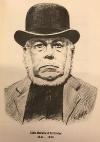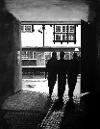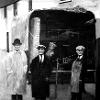Yards
Along Uxbridge High Street there are small glimpses of what was once a huge network of homes, businesses and back roads around the town, known as yards.


In Giles Hutson's 'Recollections of Uxbridge 1830-1840' we learn about dirt, filth and overflowing cesspools in many of the yards. There are even records of pigs who would roam the streets unchecked, sleeping in family dwellings and causing destruction. Only in 1848 was there an actual law introduced that would fine people for keeping a pig in a town dwelling.
Life expectancy in these yards was extremely short. In 1849 people were living in overcrowded houses and due to poor conditions one in seven children die in Uxbridge at the time with 27.7 percent dying before their fifth year. The average age in Uxbridge was only 32 years. In 1849 cholera was discovered in three of the twenty-six yards which then began to spread more violently throughout the town.
A public health inspection was undertaken in 1849, to assess the conditions of these squalid places. At the time many of these yards were described as being overcrowding with people of "questionable character", with open ditches and no sewers. This inspection was vital in the much needed improvement to the town's sanitation needs.
It was only when the Metropolitan Railway came through to Uxbridge that the demolition of the yards was really carried out. By removing people from these squalid conditions prevented any further spread of diseases and undoubtedly improved the lives of many people in the borough.
George Dudley's essay on Uxbridge Yards (2016) explores some of the lost history of the yards, as well as the photographer George Humphries, who worked for the local newspaper between 1928 and 1968. Humphries was a talented photographer who was able to capture the more human side of the yards, showing some of the people who populated these vast areas of poverty. Dudley's essay is available on request from the Hillingdon Local Studies Search room.


